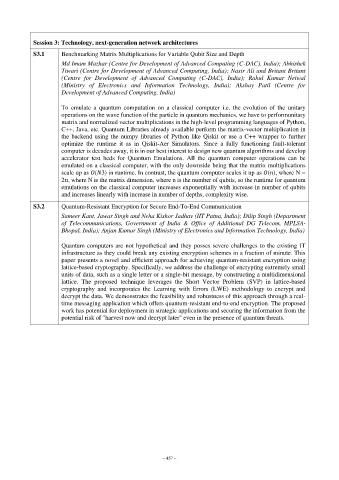Page 501 - Kaleidoscope Academic Conference Proceedings 2024
P. 501
Session 3: Technology, next-generation network architectures
S3.1 Benchmarking Matrix Multiplications for Variable Qubit Size and Depth
Md Imam Mazhar (Centre for Development of Advanced Computing (C-DAC), India); Abhishek
Tiwari (Centre for Development of Advanced Computing, India); Nasir Ali and Britant Britant
(Centre for Development of Advanced Computing (C-DAC), India); Rahul Kumar Neiwal
(Ministry of Electronics and Information Technology, India); Akshay Patil (Centre for
Development of Advanced Computing, India)
To emulate a quantum computation on a classical computer i.e. the evolution of the unitary
operations on the wave function of the particle in quantum mechanics, we have to performunitary
matrix and normalized vector multiplications in the high-level programming languages of Python,
C++, Java, etc. Quantum Libraries already available perform the matrix-vector multiplication in
the backend using the numpy libraries of Python like Qiskit or use a C++ wrapper to further
optimize the runtime it as in Qiskit-Aer Simulators. Since a fully functioning fault-tolerant
computer is decades away, it is in our best interest to design new quantum algorithms and develop
accelerator test beds for Quantum Emulations. All the quantum computer operations can be
emulated on a classical computer, with the only downside being that the matrix multiplications
scale up as ( 3) in runtime. In contrast, the quantum computer scales it up as ( ), where N =
2 , where N is the matrix dimension, where n is the number of qubits, so the runtime for quantum
emulations on the classical computer increases exponentially with increase in number of qubits
and increases linearly with increase in number of depths, complexity wise.
S3.2 Quantum-Resistant Encryption for Secure End-To-End Communication
Sameer Kant, Jawar Singh and Neha Kishor Jadhav (IIT Patna, India); Dilip Singh (Department
of Telecommunications, Government of India & Office of Additional DG Telecom, MPLSA-
Bhopal, India); Anjan Kumar Singh (Ministry of Electronics and Information Technology, India)
Quantum computers are not hypothetical and they posses severe challenges to the existing IT
infrastructure as they could break any existing encryption schemes in a fraction of minute. This
paper presents a novel and efficient approach for achieving quantum-resistant encryption using
lattice-based cryptography. Specifically, we address the challenge of encrypting extremely small
units of data, such as a single letter or a single-bit message, by constructing a multidimensional
lattice. The proposed technique leverages the Short Vector Problem (SVP) in lattice-based
cryptography and incorporates the Learning with Errors (LWE) methodology to encrypt and
decrypt the data. We demonstrates the feasibility and robustness of this approach through a real-
time messaging application which offers quantum-resistant end-to-end encryption. The proposed
work has potential for deployment in strategic applications and securing the information from the
potential risk of "harvest now and decrypt later" even in the presence of quantum threats.
– 457 –

